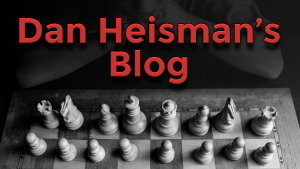Q&A with Coach Heisman Mar 29, 2013
I opened the show by randomly selecting a position from one of my Chess.com friend's slow games:
I spent about the first 15 minutes of the show analyzing the position. My general considerations were that White was slightly better due to the activity of his forces (partly due to kingside space) and his 2-1 queenside majority, more than offsetting Black's bishop pair (worth, on the average, about 0.5 pawns).
I won't try to repeat all my analysis (not that I could), but I considered candidate moves like 1.Nb3, 1.Nf3, 1.Kh1, and 1.Rf3. I wasn't so hot on the move popular in the channel, 1.f5, since Black has the only dark-squared bishop, so that f6 is rarely a threat and there is no pressure on e6 since the cramped black pieces are well-placed to defend that square. I also showed that a superficially safe move like 1.Na4 was bad due to the pseudo-sacrifice 1...Rxc4 when, after the rook is captured, Black plays 2...Bxa4 and wins two pieces for a rook. If you find yourself falling for these types of tactics, you are either playing "Hope Chess", where you don't consider all your opponent's checks, captures, and threats for his responses to your candidates, or you are making a quiescence error if you assume 1...Rxc4 is not safe for black just because he is, temporarily, giving up a rook for a bishop. Of course, it is safe because if you look one move further, you see the discovered attack of the bishop on the a4 knight.
This brought up the later question as to whether there was a sequential process I was following to do the analysis and the answer was no, not specifically. As I wrote in an earlier blog, there is no one single correct thought process. However, when pressed, I did outline a generic thought process that could be used in analytical positions in Making Chess Simple (also in my book The Improving Chess Thinker). There is a also a vaguely similar similar 5-step thought process on pages 13-14 of the new book (about what I call the Seeds of Tactical Destruction) Tune Your Chess Tactics Antenna by Neiman from NIC.
Another move championed on the channel was Rfd1. I was not so keen on that move. Although the d-file is semi-open, the rook is well placed on f1 and the target square of d6 is dark, nicely guardable by black's extra dark-square bishop.
As time went on, I started to hone in on 1.Nb3 as my favorite, i.e. "King of the Hill". The others still under consideration were 1.Rf3 and 1.Kh1. I did not finish the process, but 1.Nb3 was clearly at the top, not because it threatens 2.Na5, forking the rook and queen - that could easily be met by a queen check, but because the combination of going to possibly Na5 and/or Nd4 was flexible and it fit the general theme of increasing pressure around White's majority.
During the show and as I was finishing, someone on the channel wrote that 1.Nb3 was Houdini's top move, which made me feel good. As I was writing this article, I let Houdini 3 think 27 ply, and the top three moves were, in descending order, 1.Kh1, 1.Nb3, and 1.Rf3. That also makes me feel good, even though my top candidate had dropped to second. I've done a lot worse in the past! 
I showed my "USCF" chess cup I had, to drink tea during the show (try talking solo for 90 minutes without something to drink!), which brought up the insightful question "Do you use sugar in your tea?" and my prompt answer "No, I use honey!" probably raised the rating of each viewer at least 10 rating points  . Speaking of innocuous questions, I asked "How many chess books have I published?" and the first person with the right answer (11) got the big prize of the day - an "Attaboy!" from the show host
. Speaking of innocuous questions, I asked "How many chess books have I published?" and the first person with the right answer (11) got the big prize of the day - an "Attaboy!" from the show host  . We've come a long way from "Who Wants to Be a Millionaire?"
. We've come a long way from "Who Wants to Be a Millionaire?"
Speaking of questions, I finally figured out a way to define what kind of question might be too broad for the show:
Any question that can be answered by either writing a book or referring to entire books written on that subject is too broad for a two-minute TV show Q&A. For example, if someone asks "How do you learn planning?" then I can point to Judgement and Planning in Chess by Euwe or How to Reassess Your Chess by Silman. If someone asks I am an "A" player, how do I get to expert, I can point to How to Become a Candidate Master by Alex Dunne. You get the idea.
Someone asked if The King's Indian Defense was too complex for an 1800 player. I responded by saying that some complex openings can be played simply and some simple openings can be played complex. I think this entire idea that some openings are too tough for certain levels is a little overdone, even if there is some truth to it. I started playing the King's Indian Defense when I was about 1500, so I certainly don't think it's too much for an 1800.
Someone else asked me about light square tactics vs dark square tactics. Well, chess can be played on boards where all 64 squares are the same color. But it's easier to see bishop and queen diagonal moves when the squares alternate color, so the current pattern is good for board vision. But that's all. Any pattern you can do on "dark squares" can be duplicated on the opposite color by setting up the pieces "mirrored" across the d and e-files (eg If the White king is on f1, put it on c1, and do that for all the pieces on the board). If you do so, you will find all those light squared maneuvers by a bishop on d3 will now be dark square maneuvers by a "twin" bishop on e3 in the mirror diagram. So no, light and dark square maneuvers don't strike me as a good way to classify and study tactics (or most anything else except board color memorization, which I am not that big on either, as you might guess).
I mentioned on the show how terrible I was when I first started USCF play. Anyone familiar with the swiss system knows that I was really bad when I say that I did not win more than one game in any of my first three chess tournaments! I did not know it at the time, but I was playing Hope Chess, which is what most players do who are rated under 1650 or so (USCF). Once I realized that my opponents could make unstoppable threats and I could not just wait to see what they did to see what I should do, then I really learned how to think correctly and use my time, and my rating started to climb. See my article (My) Beginner Misconceptions.
Thanks to the viewers for their good questions and the viewers and mods for keeping the channel clean. The next show is open to all on Apr 12 at 5 PM ET. See you then!
Some links/references relevant to the show:
- Dan Heisman Learning Center
- Don't Know What to Do? Try Dan's Dirty Dozen
- book: "The World's Most Instructive Amateur Game Book" now on Ipad in live "Forward Chess" format (get the free app by that name)
- book: Pawn Structure Chess by Andrew Soltis
- book: Chess Visualization Course by Ian Anderson
- Column: Chess Mazes by Bruce Albertson (help with visualization)
- Column: The Puzzling Side of Chess by Jeff Coakley (visualization)
- Sneaky Pins and Invisible Moves
- A Planning Primer



